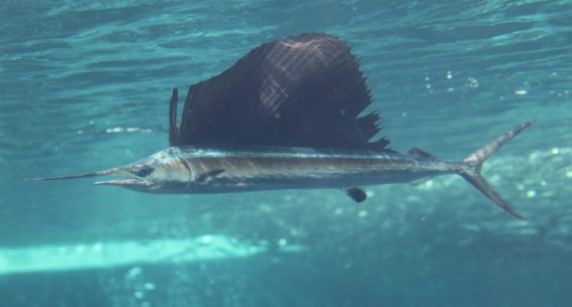
The appearance of Indo-Pacific sailfish (Bashokajiki)
Common name: Indo-Pacific sailfish, Atlantic sailfish, Bayonet fish, Billfish, Boohoo, Indian sailfish
Japanese name: Bashokajiki (芭蕉梶木、芭蕉旗魚、芭蕉舵木)
Taiwan common name: 雨傘旗魚、破雨傘、雨笠仔、芭蕉旗魚、破鐘、雨傘魚
Chinese common name: 平鳍旗鱼
Korean common name: 돛새치
French common name: Espadon voilier, Bécasse de mer, Empereur l’éventail, Empereur éventail
German common name: Pazifischer Fachertfisch, Segelfisch, Fächerfisch, Indopazifischer Segelfisch
Spanish common name: Pez vela, Pez vela del Indo-Pacifico, Abanico, Aguja De Abanico, Banderón
Russian common name: Индотихоокеанский парусник
Scientific name: Istiophorus platypterus (Shaw, 1792)
Nigiri sushi detail: Indo-Pacific sailfish (Bashokajiki) Nigiri sushi
Characteristics:
Indo-Pacific sailfish (Bashokajiki) are distributed in the warm and tropical waters of the Indian and Pacific Oceans. It does not form large schools, but rather, it works alone or in small groups of a few individuals. Its body color is dark blackish-blue on the back and grayish-white on the belly. It can grow to more than 2 meters in length. This species is the fastest swimmer among sailfish, with a speed of over 54 knots. The season is from summer to autumn.
The flesh is lean and fibrous with little fat. The meat near the tail is stringy and dry, but near the head, the stringiness is not a problem, and the fat in that part is quite tasty. It is mainly suitable for teriyaki, steaks, and fries. In the past, it was used as an ingredient in fish paste products such as chikuwa and kamaboko.
Striped marlin (Makajiki) has pinkish-red flesh like Yellowfin tuna (Kihada maguro) and is used for sushi. Generally, Broadbill swordfish (Mekajiki), Indo-Pacific blue marlin (Kuorkajiki), black marlin (Shirokajiki), and Indo-Pacific sailfish (Bashokajiki) are the least tasty. (Bashokajiki) in that order. Bashokajiki is not used for sushi topping.